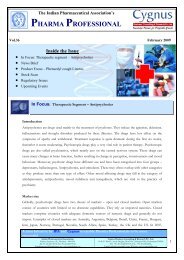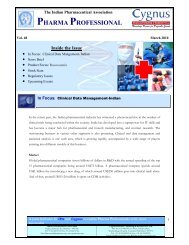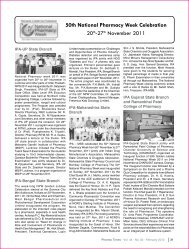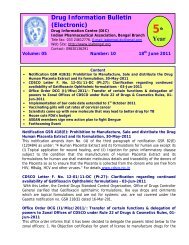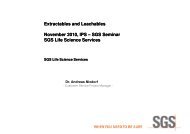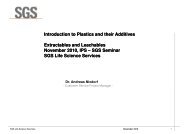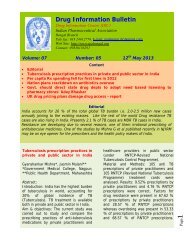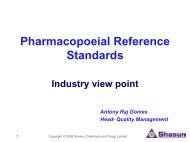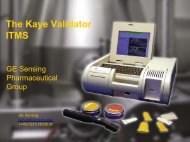Good Pharmacy Practice Guidelines - Indian Pharmaceutical ...
Good Pharmacy Practice Guidelines - Indian Pharmaceutical ...
Good Pharmacy Practice Guidelines - Indian Pharmaceutical ...
Create successful ePaper yourself
Turn your PDF publications into a flip-book with our unique Google optimized e-Paper software.
<strong>Good</strong><br />
<strong>Pharmacy</strong><br />
<strong>Practice</strong><br />
<strong>Guidelines</strong><br />
<strong>Guidelines</strong> for delivery of <strong>Pharmaceutical</strong> Services<br />
and Care in Community <strong>Pharmacy</strong> Settings in India<br />
********************<br />
<strong>Indian</strong> <strong>Pharmaceutical</strong> Association<br />
March 2002
<strong>Good</strong> <strong>Pharmacy</strong><br />
<strong>Practice</strong> <strong>Guidelines</strong><br />
<strong>Guidelines</strong> for delivery of<br />
<strong>Pharmaceutical</strong> Services and Care<br />
In Community <strong>Pharmacy</strong> Settings in India.<br />
March 2002<br />
2
The <strong>Indian</strong> <strong>Pharmaceutical</strong> Association<br />
<strong>Good</strong> <strong>Pharmacy</strong> <strong>Practice</strong> <strong>Guidelines</strong><br />
Documentation Committee<br />
Chairman Brijesh Regal<br />
Secretary<br />
Chairman, Community <strong>Pharmacy</strong> Division, (1998-2008)<br />
<strong>Indian</strong> <strong>Pharmaceutical</strong> Association, Mumbai<br />
Email: Brijesh@Apothecaries.net<br />
Raj Vaidya<br />
Email: Pharmhin@Sancharnet.in<br />
Members Ajay Pal Gupta<br />
Ashok Sakhuja<br />
Kul Bhushan Gupta<br />
M P Mittal<br />
Mohinder Bareja<br />
Pankaj Maini<br />
Pritpal Singh<br />
Ravi Narang<br />
Sunil Gadi<br />
Sunil Arora<br />
Guidance Dr. D. B. A. Narayana<br />
Managing Trustee, Delhi <strong>Pharmaceutical</strong> Trust<br />
P.D. Sheth<br />
Professional Secretary,<br />
WHO-SEARPHARM Forum<br />
First published March,2002<br />
Reprinted September 2005<br />
GPP and <strong>Pharmaceutical</strong> Care are dynamic concepts. To continually improve and update these guidelines – the<br />
practitioners are invited to send their feedback and experience to Brijesh@Apothecaries.net or to<br />
Pharmhin@Sancharnet.in<br />
This document sets guidelines. They are recommended to be followed over and above the stipulations<br />
made under the Drugs and Cosmetics Act and Rules and should always be interpreted in that context.<br />
This document may be used in part or in whole for professional purposes with acknowledgement of its<br />
source. Commercial use of this document may be made only with written consent of the <strong>Indian</strong><br />
<strong>Pharmaceutical</strong> Association, Kalina, Santacruz (E), Mumbai-400098.<br />
3
Contents<br />
Sr. No. Description Page No.<br />
Preamble 4<br />
1 Structure <strong>Guidelines</strong> 10<br />
1.1 Facilities 10<br />
1.1.1 Premises 10<br />
1.1.2 Furniture & fixtures 11<br />
1.1.3 Equipment 11<br />
1.2 Personnel 11<br />
1.3 Systems 12<br />
1.3.1 Quality policy 13<br />
1.3.2 Service policy 13<br />
1.3.3 Staff training policy 13<br />
1.3.4 Complain policy 14<br />
1.3.5 Drug Recall policy 14<br />
1.3.6 Audit policy 15<br />
1.3.7 Documentation system 15<br />
2 Process guidelines 16<br />
2.1 Procurement and inventory management 16<br />
2.2 Storage 17<br />
2.2.1 Storage management 18<br />
2.2.2 Disposal of unused pharmaceutical products and waste 18<br />
2.3 Prescription handling 18<br />
2.4 Dispensing 19<br />
2.4.1 Filling the prescriptions 19<br />
2.4.2 Extemporaneous preparation 20<br />
2.5 Information of patients 20<br />
2.6 Patient counseling 21<br />
2.6.1 Professional guidance 22<br />
2.6.2 Medication records 22<br />
2.6.3 Patient follow-up 22<br />
2.6.4 Self care 23<br />
2.7 Health Promotion and Ill health prevention 23<br />
2.8 Pharmacovigilance 24<br />
2.9 Enhancement of professional role 24<br />
2.10 Professional interactions 24<br />
4
Preamble<br />
Our society is going through a massive change in its health care needs and provisions. <strong>Pharmacy</strong><br />
itself is a profession in transition. While the profession is changing much more rapidly, now<br />
than 5 years ago, there are still too many Pharmacists who are fighting change rather than<br />
embracing it. Many in the profession are looking for someone to blame rather than deciding<br />
what they can do to move forward.<br />
The profession of pharmacy in India can seize the opportunity and respond to changes in the<br />
health care system, in part, by making pharmaceutical care its mission. <strong>Pharmaceutical</strong> care is<br />
an evolutionary and revolutionary way of practicing pharmacy. It requires complete rethinking<br />
about how Pharmacists in India have traditionally worked so far. Despite some Pharmacists<br />
confusing pharmaceutical care with patient counseling and/or disease state management,<br />
pharmaceutical care is far more complex and occurs many more challenges and opportunities.<br />
It requires that pharmacists take responsibility for preventing and solving drug related<br />
problems and optimizing drug therapy. It does not end when the patient leaves the pharmacy.<br />
Assessing (patients understanding of illness and treatment plan), monitoring, documenting care<br />
and progress and follow-up care are integral part of providing pharmaceutical care.<br />
<strong>Pharmaceutical</strong> care requires marketing and management support. While there is no doubt<br />
about the market need for pharmaceutical care, there is not a clear market demand for it yet.<br />
Patients don’t know they need it, doctors aren’t sure what it is or if they should like it, and the<br />
Government doesn’t understand it or isn’t convinced that it will really reduce health care costs.<br />
It is our job to create this demand for pharmaceutical care and for the mission of pharmacy. We<br />
are a profession in search of a savior. We are waiting for someone else to ‘sell’ our mission. Yet,<br />
experience tells us that no one would really care about pharmacy except pharmacists.<br />
Therefore, it is up to every pharmacist to market pharmaceutical care.<br />
Notwithstanding our optimism, it is hard to see how pharmacy and its practitioners will survive<br />
if they do not embrace the changes we are facing. Merely selling drugs will not keep<br />
pharmacists afloat. The absence of even a passing reference to ‘Pharmacists’ in the country’s<br />
latest health policy has sent a clear message that simply dispensing drugs has very little value.<br />
In fact, some sections of decision makers feel that pharmacists do not provide any value but<br />
merely add to the health care costs and should be removed as patient interface. Society does<br />
not want to pay for anything that does not lower costs or improve outcomes. Yet, almost all<br />
Pharmacists in India continue to merely sell medicines – arguing that they have no time to do<br />
anything but selling.<br />
What has happened to the profession of pharmacy? How did we get here? How did we lose<br />
sight of what is truly important: the patient? What we do know and understand about the<br />
patient’s illness and treatment?<br />
Are we behaving morally and ethically as a profession? When patients do not receive important<br />
information about their medicine or when their understanding of the illness and treatment is<br />
5
not assessed, we are putting people at risk. Equally, if not more importantly, do we realize that<br />
we are jeopardizing the relevance of our profession to the society.<br />
When we practice pharmacy, are we able to answer these questions? If the answer is no, then<br />
we are really getting to the root of the problem. Why don’t we know these things?<br />
<strong>Good</strong> <strong>Pharmacy</strong> <strong>Practice</strong> <strong>Guidelines</strong> aim to set standards for practice of pharmacy as a<br />
profession in India. It is also an affirmative statement conveying that we ourselves control our<br />
profession’s standards, not anyone else.<br />
We essentially and urgently need to establish and respect the conventional relationship<br />
between the patient and the pharmacist.<br />
Being professional means that what we do is not solely motivated by financial gains. In fact, the<br />
primary motivation should be service to the public. If this appears altruistic, we must realize<br />
that altruism is the foundation for professional behavior.<br />
By definition, all professional<br />
i. Render some specialised services to the society<br />
ii. Have a state enforces monopoly of rendering those services in which they engage<br />
iii. Have undergone training with specialised length and content<br />
iv. Offer consistently high and ethical standards of service to the society.<br />
These guidelines aim to provide the framework to meet the last and the most important of the<br />
above criteria that has the potential to make pharmacy profession relevant to the society.<br />
We say that pharmaceutical care should be our mission but is it our standard?<br />
Standards play an important part in the measurement of quality of service. GPP guidelines aim<br />
to set the standards for pharmacy services to be provided to the society through community<br />
pharmacies.<br />
These guidelines have been documented with the understanding and acceptance that the<br />
conditions of pharmacy practice may vary between different areas within the country. Not only<br />
is there likely to remain a difference in the pharmacy services available in our urban and rural<br />
area, the inordinate large number of retail pharmacies in most cities would keep a wide<br />
difference in level of the services provided.<br />
It is accepted that even though there are adequate ‘qualified’ pharmacists, the benefits that<br />
accrue from Pharmacists’ direct supervision in ensuring the quality of pharmaceutical products<br />
and services cannot be realized where there are insufficient number of ‘trained’ pharmacists.<br />
For the foreseeable future, ‘trained’ qualified pharmacists will continue to be in short supply.<br />
‘Qualified pharmacists’ will therefore have to take up such responsibilities and duties which are<br />
inappropriate to their current level of training. Therefore, there is a real need to organize wellstructured<br />
continuing education facilities for qualified pharmacists if implementation of GPP<br />
guidelines is to be achieved in our country. Timelines for perceptible improvement in the<br />
provision of pharmaceutical care across the country would necessarily be dependent upon the<br />
provisions made for continuing-education facilities.<br />
6
A powerful parallel force to raise the standards of practice can result by increasing the<br />
awareness of public, government and other healthcare professionals about the services that<br />
can be offered by the pharmacists and the benefits that would accrue from the full use of their<br />
expertise and knowledge. This increased awareness would serve to raise public expectations<br />
and the process is likely to become a major motivating factor for community Pharmacists to<br />
upgrade themselves.<br />
However, it will be individual Pharmacists and pharmacies that will have to decide what is the<br />
highest level of service that can be provided by them and achieving it will be their professional<br />
decision. A certain level of commitment to change will be the essential prerequisite for<br />
adoption of these guidelines.<br />
In India, Pharmacists are largely involved in the distribution role. As the number of ‘trained’<br />
Pharmacists increases, provision of dissimilation of information aimed at improving the<br />
outcomes of pharmacy-therapy would be perceptible in the society.<br />
The Drugs and Cosmetics Rules prescribe that the word “<strong>Pharmacy</strong>” be displayed by those<br />
premises which comply with Schedule N (for compounding of medicines). However, the word<br />
“<strong>Pharmacy</strong>” has been used here to progressively describe all retail medicine outlets irrespective<br />
of whether they are compounding or not. It is opined that compounding pharmacies be called<br />
as such.<br />
The objective of framing and implementing these GPP <strong>Guidelines</strong> for India is that over the next<br />
few years, all pharmacies in India should achieve these standards of practice. It is left up to<br />
individual pharmacies how they go about achieving these standards. This has to be through<br />
continuous education, training and perseverance of the pharmacists as well as the professional<br />
organizations.<br />
Even though it may seem that high level of standards have been set, the time has come for the<br />
situation in India to change from a product oriented approach to a patient oriented approach<br />
with <strong>Pharmaceutical</strong> Care the ultimate goal of pharmacy practice. As new medicines are being<br />
introduced in India at the global pace our standards of pharmacy practice will have to be set on<br />
par with standards of other pharmaceutically evolved countries sooner than later.<br />
These GPP <strong>Guidelines</strong> are like the North Star in the sky: we may never reach there but that’s<br />
where we aim to reach. They will show us the way, like the North Star does, when we do not<br />
know which way to go.<br />
Brijesh Regal<br />
March 2002<br />
Email:<br />
Brijesh@Apothecaries.net<br />
7
Definitions<br />
Chief Pharmacist: A “Pharmacist” as described above, with at least one year experience of<br />
providing pharmaceutical care to patients.<br />
Client: All persons who come to the pharmacy for obtaining medicines, cosmetics or other<br />
products and services.<br />
Community <strong>Pharmacy</strong>: the area of pharmacy practice in which medicines and other related<br />
products are sold or provided directly to the public from a retail outlet designated primarily for<br />
the purpose of providing medicines. The sale or provision of the medicine may either be on the<br />
order or prescription of a doctor or “over the counter” by the Pharmacist.<br />
Drug: All chemical or natural substances capable of being used for therapeutic purposes. The<br />
expression Drug also includes narcotics, etc.<br />
Medicine: Drugs used for therapeutic purposes. All medicines are drugs but all drugs are not<br />
medicines.<br />
Patient: A client who is suffering from an ailment and visits the pharmacy to obtain medication<br />
or advice. All patients are clients but all clients may not be patients.<br />
<strong>Pharmacy</strong>: See Community <strong>Pharmacy</strong>.<br />
<strong>Pharmacy</strong> Assistant: A person engaged by a Community <strong>Pharmacy</strong>, who does not have any<br />
formal pharmacy qualifications but has received “on the job” or “in house” training.<br />
<strong>Pharmaceutical</strong> Care: the responsible provision of pharmaco-therapy for the purpose of<br />
achieving definite outcomes that improve or maintain a patient’s quality of life. It is a<br />
collaborative process that aims to prevent or identify and solve medicinal product and health<br />
related problems.<br />
Pharmacist: A person with a formal pharmacy qualification such as a degree or diploma in<br />
pharmacy, and who is registered with the State <strong>Pharmacy</strong> Council where he is practicing the<br />
profession.<br />
Profession: A vocation that meets the following criteria:<br />
1. A state-enforced monopoly of rendering specialised services to society.<br />
2. A control over length and content of the training that is mandatory for the occupational<br />
group.<br />
3. An area of work where the society needs and receives consistently high and ethical<br />
standards of service.<br />
4. The practitioners have an accepted and enforced code of ethics.<br />
Qualified Pharmacist: A pharmacist who has adequate qualification(s) that make him/her eligible<br />
to get registered.<br />
Registered Pharmacist: A Pharmacist who is registered under the <strong>Pharmacy</strong> Act with the state<br />
pharmacy council where he normally practices.<br />
Trained Pharmacist: A Qualified Pharmacist who has adequate training to deliver <strong>Pharmaceutical</strong><br />
Care.<br />
8
1. Structure <strong>Guidelines</strong><br />
<strong>Good</strong> <strong>Pharmacy</strong> <strong>Practice</strong>s<br />
These refer to pharmacy as an organization, and give standards/guidelines for<br />
1.1 Facilities<br />
1.1.1 Premises<br />
1.1.2 Furniture and fixtures<br />
1.1.3 Equipment<br />
1.2 Personnel<br />
1.3 Systems<br />
1.3.1 Quality policy<br />
1.3.2 Service policy<br />
1.3.3 Staff training policy<br />
1.3.4 Complaints policy<br />
1.3.5 Drug Recall policy<br />
1.3.6 Audit policy<br />
1.3.7 Documentation system<br />
Structure guidelines aim to create suitable conditions for the process guidelines.<br />
2. Process guidelines<br />
These refer to the provision of pharmaceutical care and lay down the guidelines for:<br />
2.1 Procurement &inventory management<br />
2.2 Storage inventory management<br />
2.3 Prescription handling<br />
2.4 Dispensing<br />
2.5 Information for patient<br />
2.6 Patient counselling<br />
2.7 Health promotion & ill health prevention<br />
2.8 Pharmacovigilance<br />
2.9 Enhancement of professional role<br />
2.10 Professional interactions<br />
9
1. Structure <strong>Guidelines</strong><br />
1.1 Facilities<br />
1.1.1 Premises<br />
The pharmacy should be easily located & identified by the public. Exterior of the pharmacy<br />
should be maintained neat and clean. The façade should be clearly marked with the word<br />
“PHARMACY” written in English as well as in the local language(s) of the area.<br />
As far as possible, the pharmacy should be conveniently assessable to people using prams or<br />
wheel chairs etc. pharmaceutical services and products should be served from an area which is<br />
separate from the other activities/services and products. This facilitates the integrity & quality of<br />
products, and minimizes the risk of dispensing errors. The Pharmacist should be directly & easily<br />
accessible to public for information, counseling, etc.<br />
Purpose:<br />
(i) Patients may feel hesitant or uncomfortable to speak out his/her illness /about his<br />
medicine to a pharmacist when he feels he could be overheard by others.<br />
(ii) If the problem/query of the patient needs alone time (10 minutes or more), it needs a<br />
place where a patient can sit at ease.<br />
(iii) Demonstration of certain instruments,/diagnostic kits/self-usable devices (for e.g.<br />
Training the patient on making an insulin injection, or demonstrating with the help of<br />
charts or video would be better done in a secluded and related place.<br />
The pharmacy environment should be clean with minimum dust and should be maintained<br />
clean as per pharmacist cleaning schedules and SOPs. It should be free from rodents and<br />
pests/ insects and pest control measures should be taken from time to time.<br />
The pharmacy should have a constant supply of energy especially for the refrigerator(s).<br />
There should preferably be a provision for drinking water to facilitate drug administration to<br />
the patients and for use of the staff.<br />
The pharmacy should have a comfortable environment for ease/comfort of clients and<br />
personnel.<br />
The pharmacy should have:<br />
(i) Sufficient pace for clients to stand comfortably at the dispensing counter and if<br />
possible for some to sit comfortably while they wait.<br />
(ii) Space for patient information displays, including for information leaflets/ material.<br />
(iii) A separate enclosure described as “counselling Area” for patient counselling, storage<br />
of reference resources (e.g. books, internet access etc.) is a fundamental requirement.<br />
Counselling area should be a place where patients can talk freely with the pharmacist.<br />
It should be away from the area otherwise normally accessed by the patients and<br />
should preferably be an enclosure with a door which can be closed for further<br />
confidentiality. It should be well lighted with comfortable seating for the Pharmacist<br />
and the patient/attendant.<br />
10
(iv) A compounding pharmacy should also have sufficient additional space for making<br />
extemporaneous preparations, besides the necessary equipment for doing so.<br />
(v) Separate waste collection baskets/boxes should be available for the staff and for the<br />
clients.<br />
The products storage area should be protected from exposure to excessive light and heat.<br />
Ambient temperature in the pharmacy should be maintained within the stipulated range to<br />
prevent deterioration of various medicines stored at room temperature conditions.<br />
1.1.2 Furniture and fixtures<br />
The pharmacy should have neat, well placed shelves with provision for storage of<br />
medicines and other items in a neat manner, protected from dust, moisture, excessive light.<br />
Adequate provisions should be available for storing various medicines at prescribed<br />
temperature conditions.<br />
The counseling area should be furnished with:<br />
(i) A table.<br />
(ii) Chair for the Pharmacist and a couple of patients<br />
(iii)Cabinet for storing patient medication records (PMRs)<br />
1.1.3 Equipment<br />
The pharmacy should be equipped with refrigerated storage facilities (validated from time to<br />
time) and should be available for products requiring storage at cold temperature.<br />
The counseling area should be equipped with:<br />
(i) Reference material<br />
(ii) Demonstration charts, kits and other demonstration material.<br />
(iii)Patient information leaflets (PILs)<br />
(iv) Some basic instruments for e.g. Sphygmomanometer, glucometer, Snellens chart,<br />
stethoscope, etc.<br />
(v) Weight and height scale<br />
The pharmacy should preferably be equipped with computers and appropriate software that can<br />
1. Manage inventory<br />
2. Manage invoicing<br />
3. Generate timely warning for expiring medicines<br />
4. Archive patient medication records<br />
The computer should also be equipped to give demonstrations to the patients and other relevant<br />
purposes.<br />
Compounding section of the pharmacy should be equipped as prescribed under Schedule N to the<br />
Drugs and Cosmetics Rules. Other equipment, as necessary for operations, should also be<br />
available.<br />
1.2 Personnel<br />
11
The Community <strong>Pharmacy</strong> should be managed under the overall supervision of a chief<br />
pharmacist, who will have the final responsibility for all the professional activities and<br />
operations.<br />
All staff members including newly recruited staff should be trained as per the staff training<br />
policy of the pharmacy.<br />
All activities in the <strong>Pharmacy</strong> should be carried out as per well documented guidelines and<br />
procedures, which should have been framed by the management in consultation with the Chief<br />
Pharmacist.<br />
Each staff member should have clearly allotted responsibilities, which must be performed<br />
according to documented standard operating procedures.<br />
All personnel in the pharmacy must, at all times, wear a neat apron/ coat. All Pharmacists should<br />
additionally wear a badge prominently displaying their name and the word “Pharmacist”.<br />
Additionally, a recent photograph, qualification certificate and the State <strong>Pharmacy</strong> Council<br />
Registration Certificate may be displayed in clear view of the clients entering the pharmacy.<br />
Due to regular exposure to patients some of whom may be carriers of contagious diseases all<br />
pharmacy personnel should wear medically examined and adequately immunized periodically<br />
and their health data should be archived.<br />
Pharmacists working in the pharmacy should:<br />
1. Hold at least a Diploma in <strong>Pharmacy</strong> and preferably a degree in <strong>Pharmacy</strong>.<br />
2. Be registered as a pharmacist with the <strong>Pharmacy</strong> council of the state in which he/she is<br />
practicing.<br />
3. Have undergone adequate practical training in a community pharmacy.<br />
4. Undergo in house training as per the organisation’s staff training policy.<br />
5. Have communication skills & capabilities to give adequate and proper advice to the<br />
clients on the appropriate use of medicines, illness, etc. so as to achieve optimal patient<br />
compliance.<br />
Each Pharmacist working in the pharmacy must be competent enough to:<br />
(i) Play a professional role to assess prescriptions.<br />
(ii) Advise the patients on appropriate selection and use of OTC medicines.<br />
(iii)Advise patients on appropriate use of prescribed medicines.<br />
(iv) Check & advice on drug-drug and drug-food interactions.<br />
(v) Be alert for adverse drug reactions.<br />
(vi) Comprehend the client’s condition or illness and provide advice on proper use of<br />
medication and diet.<br />
(vii) Assess the patient’s condition and decide when to refer him/her to the doctor.<br />
(viii) Perform the role of a health care provider and a counsellor.<br />
1.3 Systems<br />
The pharmacy should have well defined and documented systems for each operation carried out<br />
in the pharmacy.<br />
12
1.3.1 Quality Policy<br />
It is a general declaration of the intent of the pharmacy about the level of quality of service and<br />
products offered to the public.<br />
Quality goals emanate from the stated quality policy and they are the targets, which are set and<br />
which can be in a stipulated period of time. Different quality goals need to be set in the various<br />
operational areas of the pharmacy.<br />
It is the responsibility of the Chief Pharmacist to formulate a Quality Policy and set and achieve<br />
Quality Goals along with the management and other staff.<br />
The pharmacy should have a quality manual, which should state, in detail, the necessary steps to<br />
be carried out for fulfillment of the desired quality goals. The manual should also enlist the<br />
details of the activities, routines, distribution of responsibilities, work procedures and<br />
instructions that are necessary for achieving the quality goals in day-to-day operations in the<br />
pharmacy. The Quality Manual should be accessible to the staff of the pharmacy for their easy<br />
reference.<br />
All the activities mentioned in the Quality Manual should be well documented, and it shall be the<br />
final responsibility of the Chief Pharmacist to ensure that the pharmacy quality goals are in<br />
consonance with the quality policy of the pharmacy.<br />
The Chief Pharmacist should ensure that the quality policy and quality goals are understood,<br />
implemented and maintained throughout the operations in the pharmacy. Timely audits should be<br />
conducted to check the extent to which the pharmacy meets its quality goals and the outcomes<br />
should be documented for a review to further improve the process.<br />
1.3.2 Service Policy<br />
Service policy is a statement of the nature of services provided in the pharmacy and the standards<br />
laid down for the provision of those services.<br />
The pharmacy should have a well-documented service policy based on its client servicing goals.<br />
Service policy statement should include issues like home delivery of products, the nature and<br />
level of attention to be given to clients of<br />
Various kinds (e.g. elderly clients, regular clients, etc.). The service manual should state, in<br />
detail, the necessary steps to be carried out for providing each service offered in the pharmacy.<br />
Promptness of service, service time and pharmacy operation schedule, etc. form an important<br />
part of the service policy. The manual should also enlist the details of the activities, routines,<br />
distribution of responsibilities, work procedures and instructions that are necessary for provision<br />
of the services in day to day operations of the pharmacy.<br />
1.3.3 Staff Training Policy<br />
A well-conceived and implemented staff training policy has the potential to determine the future<br />
of the pharmacy in the community in which it operates.<br />
Availability of adequate reference resources (books, current periodicals, software, etc.) in the<br />
pharmacy is the fundamental requirement of the training process.<br />
13
Training policy should encompass the needs evolving out of service policy of the pharmacy. The<br />
policy should prescribe the content & frequency of the training and the training resources.<br />
Training policy should ensure that all personnel in the pharmacy are kept abreast of the<br />
developments in their fields. Upgrading communication and inter-personal skills should form the<br />
core of the training policy so that pharmacy personnel can operate in tandem with other<br />
healthcare providers on one end and are able to form professional bonds with the clients on the<br />
other. Efforts should be made to involve professional representatives of pharmaceutical<br />
companies in the trading process.<br />
The policy should prescribe the minimum continuing education levels to be attained by each staff<br />
member so that the ultimate goal of pharmacy-provision of <strong>Pharmaceutical</strong> Care – is achieved.<br />
All pharmacy personnel should be aware of Quality Policy of the pharmacy, and should be<br />
conscious about their role of delivering health care to the clients. They should be trained & made<br />
aware of minimal personal hygiene levels, as well as the level of hygiene to be maintained in<br />
storage and handling of medicines.<br />
Special emphasis should be laid on training<br />
(i) Pharmacists: in communication & counselling skills, handling of prescriptions & clients,<br />
continuing education in illnesses & drugs, latest developments in the field of<br />
medicine and pharmacy and general health matters, on “when to refer” to a doctor.<br />
(ii) <strong>Pharmacy</strong> assistants: in communication skills, salesmanship, handling of prescriptions,<br />
dispensing of drugs, procurement & storage of drugs, and “when to refer” to a<br />
Pharmacist for counselling.<br />
Procedures for imparting education/training should be well documented, and carried out as per a<br />
predetermined schedule.<br />
Training process should be well documented and reviewed periodically.<br />
Pharmacists should be encouraged to keep their knowledge up-to –date through scientific<br />
literature, textbooks, journal and periodicals, workshops, etc. Networking with pharmacists in<br />
other pharmacies should be encouraged.<br />
Management and the Chief Pharmacist shall be responsible to continuously train the human<br />
resources available in the pharmacy to ensure maximum benefits to the community.<br />
1.3.4 Complaints policy<br />
The pharmacy should have a complaints policy which should be reviewed from time to time. All<br />
complaints-oral or written- must be immediately addressed by the pharmacist, and suitable action<br />
be taken to amend the situation.<br />
The complaint, its nature, the erring person’s name and the action taken must be documented in a<br />
complaint register. The event should be reviewed and evaluated to find the underlying cause(s).<br />
Appropriate steps should be taken to amend the operating procedures or other guidelines so as to<br />
prevent the recurrence of the same or similar events.<br />
1.3.5 Drug Recall Policy<br />
The Pharmacist should have a well-documented recall policy:<br />
14
(i) The pharmacy should proactively participate in any state wide or nationwide recall<br />
process for any substandard drug. All such records should be initiated upon receiving<br />
authentic information and alarms to do so. The initiation, progress and completion of<br />
recall should be well documented. Adequate vigilance must be maintained to look out<br />
for recall alarms from regulatory sources as well as from pharmaceutical companies.<br />
(ii) In case of any suspicion, the pharmacist should take immediate steps to stop the sale of<br />
drug and notify the relevant parties.<br />
(iii) If the pharmacist has a suspicion or a reason to believe that short comings have<br />
occurred in the process of delivery of medicines from the pharmacy, immediate<br />
effective measures should be initiated to minimise the risk of damage or danger to the<br />
patient(s).<br />
1.3.6 Audit Policy<br />
Audits are conducted to check whether the Quality Management Systems are functioning<br />
properly, and as per guidelines set forth in the Quality Manual, to see whether the desired<br />
objectives of the pharmacy are being achieved. By a Quality Audit, the Chief Pharmacist can<br />
evaluate the different routine processes and the quality systems in the pharmacy, and check<br />
whether the systems are functioning as per requirements. This is achieved by frequent internal<br />
audit and a periodic external audit. Based on the audit reports, steps should be initiated to make<br />
necessary improvements.<br />
The internal audit can be conducted by the chief pharmacist along with the senior staff or<br />
members of the management team. The staff deployed for internal audit should be adequately<br />
trained for the purpose. Audit may be carried out once in six months, or more frequently.<br />
An external audit must be done at least once a year by external auditors, who are competent to do<br />
so and are appointed by the management.<br />
All audit procedures should be suitably documented. The audit report should be used to analyze<br />
the weaknesses and defects in the system so that rectifications are initiated.<br />
1.3.7 Documentation system<br />
Documentation is one of the core activities for achieving and maintaining quality. The overall<br />
responsibility for documentation rests with the chief pharmacist.<br />
All necessary statutory documents (for e.g. regulatory licenses, registrations, permissions, etc.)<br />
for operating a pharmacy must be adequately maintained and should be displayed if required<br />
under the law. In all cases they should be easily accessible whenever required.<br />
All operational documents, for e.g., purchase invoices, sales invoices, and other r statutory<br />
documents should be maintained and archived as prescribed by the law.<br />
There should also be adequate control and maintenance of documents that form a part of the<br />
pharmacist’s quality system.<br />
Some of the necessary documents include:<br />
(i) Protocols<br />
(ii) Standard Working Procedures<br />
15
(iii)Operation instructions<br />
(iv) Quality Manual<br />
(v) Cleaning and maintenance processes and records<br />
(vi) Complaint records<br />
(vii) Audit records (internal and external)<br />
(viii) Policy documents<br />
(ix) Personal details<br />
In addition, the documents required for the pharmaceutical care process should also be<br />
adequately maintained and stored. These documents include:<br />
(i) Patients’ health profile<br />
(ii) Patients’ medication records<br />
(iii)Records of counselling follow-ups, etc.<br />
2. Process guidelines<br />
The pharmacy should develop and maintain a safe, effective operational and socio-economically<br />
acceptable operation system. As far as possible, the chief pharmacist should ensure that<br />
medicines and other health care products are readily available in the pharmacy in sufficient<br />
quantities. The operational system should be socioeconomically effective so that the<br />
pharmacists’ financial interests are maintained while providing optimal health and cost benefits<br />
to the clients.<br />
2.1 Procurement and inventory management<br />
Vendors and purchasing:<br />
The pharmacist should ensure that the source of supply of medicines and other items meet the<br />
standards laid down in the law. Where no regulatory standards have been prescribed the chief<br />
pharmacist has the additional responsibility to protect the interest of clients and the pharmacy<br />
from being cheated by substandard supplies.<br />
The chief pharmacist should satisfy himself about the reliability and adequacy of the matches<br />
deployed by the vendor’s chain to ensure that all products have been handled in appropriate<br />
storage and transit conditions. Details of the vendors (for e.g. their addresses, contact numbers,<br />
names and addresses of their management persons, technical persons and administrative staff,<br />
copies of various licenses held by them should be maintained). A written communication<br />
regarding the list of authorized representatives of the vendors and their specimen signatures<br />
should be maintained and archived. Responsible designated person(s) from the pharmacy should<br />
visit the vendor’s premises from time to time for conducting audit of their premises and systems<br />
to the extent they are likely to affect the quality of the products. Errors made by the vendors<br />
should be brought to the notice as soon as possible and get rectified. All errors made by the<br />
vendors, nature of errors, repetition of the same errors, method and time frame of rectification<br />
should be documented and reviewed periodically to prevent their recurrence.<br />
16
The chief pharmacist may consider informing the regulatory authorities in case there are reasons<br />
to believe deliberate, dubious activities by the vendors(s).<br />
It is important to store products manufactured by reputed companies. The pharmacist should<br />
maintain a ‘products list’ where all items ‘approved’ by the pharmacy for stocking are described.<br />
This will discourage the non-approved and low quality medicine vendor, who may otherwise try<br />
to sell drugs, which may not be of standard quality and/or those which do not have a proven<br />
safety profile.<br />
This list may be reviewed and updated as often as necessary. Any new items added to the<br />
inventory must be first included in the list after a professional review by the chief pharmacist.<br />
Where the pharmacy operations are managed using computers the item must first be entered into<br />
the database and then ordered for procurement.<br />
Ideally, the product lists also specify the location of that product in the pharmacy. Adequate cost<br />
– effective purchasing methods should be followed which ensures adequate inventories leading<br />
to optimal financial gain for the pharmacy. In-house benchmarks for various categories of<br />
products should be set for minimum-remaining - shelf –life at the time of procurement.<br />
All products received from vendors should be tallied against their invoice and checked for<br />
correctness of quality, price, batch number and expiry date. Any anomalies should be brought to<br />
the notice of the supplier /s and suitable rectification got done. All such rectification should be<br />
documented and got authenticated by an authorized representative of the vendor.<br />
The purchase records/invoices should be maintained as stipulated under the law.<br />
2.2 Storage<br />
2.2.1 Storage management<br />
A products coming into the pharmacy should initially be quarantined, preferably in the separate<br />
area, before they are checked for correctness of quality, batch number, expiry, integrity, etc. after<br />
necessary, checks, they should be transferred to their respective storage location.<br />
All drugs should be stored at stipulated temperature areas, protected from excessive light, dust,<br />
and humidity. Temperature at various areas should be recorded at predetermined periodicity and<br />
daily records should be preserved for a period of 2 years. They may be correlated with the<br />
subsequent years’ corresponding data to improve arrangements for maintenance of temperatures.<br />
The medicines and shelves should be maintained clean and dust free at all times by following<br />
cleaning schedules and SOPs. Prescription drugs should be maintained be kept in such a manner<br />
that they are out of reach of clients. All the drugs that are to be stored in a ‘cold’ temperature<br />
should be kept in the refrigerator unless the ambient temperature in the area is cold enough.<br />
Drug and dosage form that special care while dispensing (e.g. drugs specified under the schedule<br />
X, Narcotic drug and Psychotropic Substances Act and some other CNS drug etc.) should be<br />
kept under lock and key. The key for this should be available only with the Pharmacist in-charge<br />
at the time. Records of purchase and sales of such medicines should be kept as per legal<br />
requirement.<br />
Shelves should be checked at a predetermined periodicity to ensure removal of drugs whose<br />
expiry date is approaching. In-house threshold period should be set and followed foe such<br />
17
etrieval of drugs from the shelves. The near expiry products should be stored separately and<br />
disposed of either by returning to the respective vendors or by expending their dispensing.<br />
Drugs, which have already expired, should be stored separately in a locked shelf. Bearing the<br />
label “Expired <strong>Good</strong>s Not For Sale”. Care should be taken that such goods do not reach the client<br />
in any case. Expired drugs should be returned to the supplier or destroyed as per in-house<br />
procedure at the earliest.<br />
2.2.2 Disposal of unused pharmaceutical products and waste<br />
The unused and unopened pharmaceutical products (non-saleable or expired) lying in the<br />
pharmacy should be listed and returned to the respective vendor who would in turn send them<br />
back to the manufacturer. However in case this is not possible the same may be disposed off as<br />
per the pharmacy’s standard operations procedures in this regard.<br />
2.3 Prescription handling<br />
Client must be made to feel attended and comfortable by friendly gesture and ambience as soon<br />
as they come into the pharmacy. Communication should be opened in such a way by that it<br />
encourage the client to convey his/her needs by producing a prescription or by asking for other<br />
products or advice.<br />
2.3.1 Upon receiving the prescription , the Pharmacist should confirm:<br />
(i) Identity of the client<br />
(ii) Whether the prescription is presented by the client himself or by someone on the<br />
client’s behalf.<br />
2.3.2 The client may be politely requested to wait while the pharmacist review the<br />
prescription for:<br />
(i) therapeutic aspects (<strong>Pharmaceutical</strong> 7 pharmacological)<br />
(ii) Appropriate for an individual<br />
(iii) Social, legal & economic aspects<br />
(iv) Legality & completeness of prescription<br />
2.3.3 Prescription should be complete with regard to:<br />
(i) Name of the Doctor, his /her address and registration number.<br />
(ii) Name, address, age, sex of the patient<br />
(iii)Name(s) of the medicine(s), potency, dosage, total amount of the medicines to<br />
be supplied.<br />
(iv) Instruction to the patient<br />
(v) Refill information if any<br />
(vi) Prescribed doctors’ usual signature.<br />
Any ambient, confusion, shortcoming or anomalies should be brought to notice of the<br />
prescribing doctors.<br />
18
2.3.4 Correctness of prescribed medicines<br />
The prescription should be checked for:<br />
(i) Dosage: Whether the dosage prescribed is within the standard minimum and<br />
maximum dose range.<br />
(ii) Double medication (same drug or different drug with same pharmacotherapeutic<br />
effect) concurrently prescribed by the same Doctor or by two or more doctors to<br />
the same patients undergoing concurrent treatment by more than one doctor.<br />
(iii) Interaction between the currently prescribed medicines, OTC medicines being<br />
taken by the patient & the medicines being taken from any past prescription<br />
(records of which may be available in the Patient’s Medication Records). Any drug<br />
interaction likely the render the therapy ineffective or cause undesirable effects to<br />
the patients should be brought to notice of the prescribing doctor.<br />
(iv) Contraindication: age, sex, disease(s), conditions or other characteristics of a<br />
patient that may cause certain prescribed medicines to be contraindicated.<br />
(v) History of overuse, under use, or misuse of medicines by the patient.<br />
Any of the above as well as handwriting legibility problem should be brought to the notice of the<br />
prescribing Doctors. Any necessary change made by the doctor should be recorded on the<br />
prescription, with the words “Changes made over the telephone in consultation with the Dr.<br />
(name) at (time) on (date)” and should be signed and stamped by the pharmacist. This exercise<br />
necessitates a trust based professional relationship with the prescribing doctor incise of any<br />
doubt the prescription should be got suitably amended from the doctor.<br />
2.4 Dispensing<br />
2.4.1 Filling the prescription<br />
The medicine should be removed from the storage area, counted and invoiced. In all cases, final<br />
review of prescription and the correctness of dispensed medicines must be personally made by<br />
the pharmacist.<br />
As a final step, the pharmacist should personally dispense the medicines, at which stage<br />
appropriate counseling should be given for the patient.<br />
The medicines should be packed neatly so that their integrity is maintained any medicines<br />
requiring special storage condition e.g. cold place (2-8◦C) must be packed in cold packs so that<br />
they remain at the stipulated temperature till they are taken from a larger bulk pack then they<br />
should be packed in a clean, food grade glass or plastic bottle or in a clean envelop and neatly<br />
labeled as provided under the lock.<br />
Appropriate counseling/guidelines must be given for the patient as recommended below under<br />
patient information (section 2.5).<br />
19
Conscious efforts should be made to ensure that the patients’ waiting time is kept at minimum,<br />
while all the necessary steps are carried out systematically. This can be archived by several<br />
management options e.g. by deploying and appropriate staff to clients’ ratio.<br />
2.4.2 Extemporaneous preparations<br />
Written standard operating procedures as well as standard formulations should be maintained for<br />
commonly made extemporaneous preparation. Proposed adjuvants, their quantities and method<br />
of preparation must be written down before any compounding activity is initiated. Each step<br />
should be followed methodically and step by step record maintained. Batch numbers of each<br />
medicines used for compounding should be recorded. All such preparation should preferably be<br />
compounding by the Pharmacist, only under direct supervision of a pharmacist.<br />
Only medicinal quality or better grade ingredient should be used for compounding. The<br />
preparation area should be cleaned immediately before and after compounding. All necessary<br />
weighing, measuring instrument must be calibrated periodically and records maintained.<br />
After compounding, the product should be transferred to a suitable container and closed securely.<br />
The container should be appropriately labeled stating name of the preparation, date of<br />
preparation, name of the patient, direction, quantity, a reference (batch) number generated by the<br />
pharmacy, storage conditions and name of the pharmacy. These details must be recorded in a<br />
register or electronically for suitable reference and retrieval as and when required.<br />
2.5 Information for patient<br />
Pharmacists’ fundamental concern is welfare of the client. Clients responsible to make decisions<br />
regarding his/her health must be respected at all times. Therefore, the pharmacist must help the<br />
client in making well – informed decision about proper use of medicines & other health care<br />
products. Pharmacist should support the client in making well – considered decision with regard<br />
to self – care.<br />
Whenever a pharmacist has doubt or reasons to believe that it would be in better interest of the<br />
client, he/she must advice the client is to see a doctor or another health care provider as soon as<br />
possible.<br />
Pharmacist should offer the client sufficient opportunities for personal consultation, and should<br />
ensure that are aware of this possibility.<br />
Pharmacist should provide oral as well as written information about various illness, medicines &<br />
other health care products, in order to increase the awareness level of the client regarding his<br />
illness and his medicines. The goal of consultation is to achieve maximum compliance. As far as<br />
possible, delivery of medicines to the client should be supported by written information.<br />
All dispensed medicines should ideally be provided with a label, which clearly states:<br />
(i) Name of the patient<br />
(ii) Name, strength, batch number and expiry of the medicine, in case the medicine has<br />
been repacked or cut out from a larger pack<br />
(iii) Dosage and usage instructions<br />
20
(iv) Date of delivery<br />
(v) Storage instructions<br />
(vi) Name and address of the pharmacy<br />
Dosage and usage information must also be given verbally to the client.<br />
It must be ensured that the information and advice given is correct, clear, explicit, up-to-date<br />
and understandable to the client. It should be given in a language and at a level of complexity<br />
that is easily understood by the client nature and quantity of information and advice, as well as<br />
the way these are provided, often need to be suited to the clients needs and wishes. The<br />
attitude of the pharmacist towards the client must guarantee a correct understanding and a<br />
sufficient confidence in the information provided.<br />
2.6 Patient Counseling<br />
The Pharmacist must work out strategies to make time to provide professional counseling with<br />
regard to use of medicines and related products, so as to improve the quality of the patient’s<br />
life. While dispensing, the patient should be explained:<br />
(i) How to take the medications.<br />
(ii) For how long.<br />
(iii) When to take the medicines and whether to take the medicines and whether to take<br />
them before, during or after meals, etc<br />
(iv) What foods/beverages/tasks to avoid during the therapy.<br />
(v) What side effects to expect and how to manage them.<br />
(vi) What to do if one or more doses get skipped.<br />
(vii) Any other precautions.<br />
Appropriate discretion should be exercised while discussing the nature of illness, its cause,<br />
prognosis (course of the disease), and the expected outcomes of the therapy.<br />
Patients’ counseling should ideally be done in the counseling area or where separate area is not<br />
available – in such an area of the pharmacy where the conversation is not overheard by others.<br />
As far as possible, oral information given to clients should be supplemented by additional<br />
written information (in the form of Patient Information Leaflets) about their illness and the<br />
medicines. To reinforce the understanding and improve compliance, the patient should be<br />
asked to explain what has been conveyed. Depending on the local needs and understanding<br />
levels of the clients, the Chief Pharmacist should devise methods to improve patient<br />
compliance.<br />
A list of general and specialized healthcare professionals and facilities (including laboratories) in<br />
the locality and the city should be maintained and made available to the clients whenever<br />
necessary.<br />
2.6.1 Professional guidance<br />
21
Pharmacists should make all efforts to deliver pharmaceutical care to his clients.<br />
This can be achieved by providing various professional services to the patients.<br />
2.6.2 Medication records<br />
The pharmacy should maintain individual Patient Medication Records in a system (manual or<br />
computerized) which allows for easy retrieval of patients’ health and medication history.<br />
The medication history of patient may be taken depending on the following conditions:<br />
(i) Whether the patient is suffering fro a chronic ailment.<br />
(ii) Whether the patient needs to monitor and control certain values or conditions e.g.<br />
blood pressure, asthma, cholesterol, blood sugar level, etc.<br />
The most generic format for Patient Medication Record should cover the following:<br />
(i) All medicines taken during the last one year or more (name of the medicine, potency,<br />
dose taken, duration for which it was consumed)<br />
(ii) Are there any known allergies or hypersensitivity reactions to any medicine(s)?<br />
(iii) Adverse drug reactions, drug interactions encountered by the patient.<br />
(iv) What medication, if any, was give to manage the reaction.<br />
(v) Id there any dependence on any drug(s) or medicine(s) and does the prescribing doctor<br />
know of these?<br />
(vi) Does the patient regularly consume alcoholic beverages, tobacco, tea or coffee<br />
(frequency and amount may be recorded).<br />
(vii) Have there been any problems with medicines e.g. difficulty in swallowing etc.<br />
(viii) Professional advice given from time to time.<br />
All data and information related to the patients should be stored and maintained in such a way<br />
that it remains confidential and is accessible only to the authorized persons. Such data may be<br />
shared with other healthcare professionals usually at the specific request of the patient or<br />
when it is in the best interest of the patient.<br />
2.6.3 Patient follow-up<br />
Continuity of care is essential to many patients, particularly those with chronic conditions.<br />
Pharmacists should track medications taken by such patients and regularly update the patient’s<br />
medication history as long as the patient is under his/her care. Whenever the Pharmacist has<br />
any reason to believe that another healthcare provider would be able to give better treatment<br />
to the patient, the patient should be given a referral slip stating the condition of the patient and<br />
the medication received by the patient so that the other healthcare provider can be referred.<br />
Pharmacist’s name and pharmacy contact numbers should be stated on the referral slip so as to<br />
facilitate any further inquiries by the other healthcare provider.<br />
Follow up may be accomplished during subsequent visits of the patient or through telephone<br />
calls backs for which the patient’s consent may be obtained.<br />
22
The pharmacist must personally make the follow-up calls or meetings and enquire about:<br />
(i) Patient’s general condition and response to therapy.<br />
(ii) General problems, adverse events encountered by the patient.<br />
(iii) Dose and frequency at which medicines have been taken by the patient.<br />
(iv) Missed doses.<br />
Possible causes of non compliance by the patient should be evaluated and the patients<br />
counselled accordingly. The pharmacist should keep the patient’s doctor updated about all the<br />
adverse events reported by or elicited from the patient and the stated or probable reasons for<br />
the patient not complying with the prescription/therapy.<br />
2.6.4 Self Care<br />
<strong>Pharmacy</strong> should have a clearly stated health promotion policy under which its Pharmacists<br />
should promote self care by clients. Programmes and campaigns may be conducted to promote<br />
healthy lifestyles and prevention of ill health through appropriate diet, regular exercise,<br />
avoiding alcohol, tobacco, excessive tea or coffee, etc. Misuse and abuse of drugs and<br />
medicines should be particularly reinforced.<br />
Pharmacist may promote informed self-medication or suggest / offer non prescription<br />
medicines, when preventive measures fail and the patient’s condition does not appear to be<br />
serious. The patient must be referred to a doctor if the Pharmacist is unsure of the condition<br />
and has a reason to believe that referral would be in the best interest of the patient. Even when<br />
an advice or a non prescription medication has been given to the patient he/she must be<br />
advised to refer to a doctor if the symptoms persist beyond three days or whenever the patient<br />
feels worse. <strong>Pharmacy</strong> should have written protocols for offering advice for self-medication,<br />
offering non-prescription drugs and the information that must be given to the clients in both<br />
these cases. The pharmacy should maintain a record of all such patients and advises &<br />
medicines given to them.<br />
2.7 Health promotion & ill health prevention<br />
The Chief Pharmacist must keep himself aware of the national policies and various programmes<br />
related to health. The pharmacy should proactively participate in health promotion campaigns<br />
and programmes at the local as well as national level. This can be achieved by distributing<br />
patient information leaflets, displaying posters and informative material in the pharmacy, etc.<br />
The pharmacy should be in a position to give advice to and assistance on some selected topics<br />
like diabetes, hypertension, arthritis, AIDS, breastfeeding, use of devices, appropriate usage of<br />
medicines, etc.<br />
Personnel involved in such campaigns should necessarily be educated through continuing<br />
education programs, regular interactions with other healthcare providers and should have<br />
practiced communication skills.<br />
23
2.8 Pharmacovigilance<br />
The Pharmacist should be alert to the occurrence of adverse effects (expected or unexpected)<br />
to medicines during active conversation with the patient.<br />
These should be recorded in the individual Patient Medication Records. The Pharmacist should<br />
give suitable instructions to the patient to reduce the adverse effects in the future, e.g. by<br />
advising the patient hw to take the medicine correctly, what other medicines or food to avoid,<br />
any activities that the patient should avoid ( e.g. not going out in the sun, not driving, etc.), or<br />
by consulting the prescribing doctor .<br />
If participating in pharmacovigilence programme the occurrence of adverse event should also<br />
be recorded in the programme’s prescribed format and forwarded to the coordinating center.<br />
2.9 Enhancement of professional role (Development of professional competence<br />
working with other health care providers)<br />
Pharmacists should keep themselves updated about the developments in their profession. They<br />
should possess excellent communication skills to be able to work closely with other healthcare<br />
providers and mutually share the learning.<br />
Pharmacists must maintain healthy relationship with other health care professionals.<br />
In case of any discrepancy / doubt in the prescription, the Pharmacist should contact the doctor<br />
over the telephone without unduly alarming the patient, & in a friendly manner, put forward<br />
the query to the doctor.<br />
Before doing so, he must doubly check & ensure that there is really an error or discrepancy in<br />
the prescription, and also work out the alternative /solution which can be promptly suggested<br />
on inquiry from the doctor.<br />
2.10 Professional interactions (organizing professional meetings for the community’s<br />
healthcare professionals)<br />
Up-gradation of professional skills and improved understanding between various healthcare<br />
professionals in the locality can be achieved through this process.<br />
24



